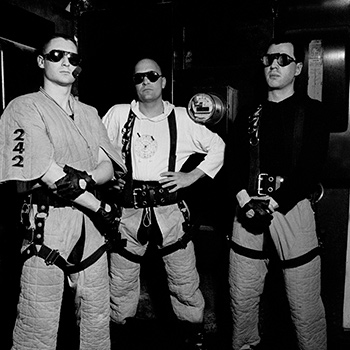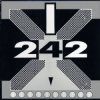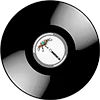
Front 242 — a Belgian outfit from Brussels/Aarschot, pioneers of Electronic Body Music (EBM) and one of the key groups that shaped the language of 1980s industrial electronics. Founded in 1981 by producer Daniel B. (Daniel Bressanutti) and musician Dirk Bergen; in 1982 vocalist Jean-Luc De Meyer and keyboardist Patrick Codenys joined (after a merger with their duo Under Viewer), and in 1983 the lineup was completed by frontman-percussionist Richard “23” Jonckheere. The signature style: martial rhythms, sequencers, spoken/ showcase-style vocals, meticulously crafted sampling, and a strict visual identity.
Early years (1981–1984): the birth of EBM
The debut album Geography (1982) set the course: minimalist electronics with no guitars, motorik drum-machine pulse, a “bodily” groove. On Endless Riddance (EP, 1983) and No Comment (1984) the band cemented the term Electronic Body Music to describe their own hybrid of industrial, synth-pop, and proto-techno. A hallmark was “working at the limit of resources”: multitrack cassette and early digital techniques that turned the dance floor’s “body” into the primary meter of music.
Breakthrough and canon (1985–1991)
From the mid-1980s Front 242 moved onto the international stage (PIAS in Europe, Wax Trax! in the USA). Pivotal releases:
-
Politics of Pressure (EP, 1985) — a hard rhythmic statement.
-
Official Version (1987) — the sound crystallized; tracks “Masterhit,” “Quite Unusual,” “Im Rhythmus Bleiben.”
-
Front By Front (1988) — the classic-era peak; “Headhunter” (video by Anton Corbijn) and “Welcome to Paradise” became EBM anthems.
In this period the group forged a reference live format: synchronization of sequencers, percussion and visuals, strict choreography, and a “para-military” visual code.
Transformation and long forms (1991–1994)
Tyranny (For You) (1991) added a distinct techno impulse and more complex arrangements (a studio high point). In 1993 two “sister” full-lengths arrived with different dramaturgy and production optics:
-
06:21:03:11 Up Evil — more “organic” and song-driven within EBM;
-
05:22:09:12 Off — experimental, sparse, focused on sound design.
Meanwhile the members developed side projects and collaborations.
Hiatus, reincarnations and the “new” Front 242 (1995–2010)
Mid-1990s: reduced studio activity and a focus on live releases (Live Code (1994), Re-Boot: Live ’98 (1998)), where classic material was reimagined in a more techno-oriented manner. The studio return came with the pair Pulse (2003) and Still & Raw (2003): a “cold” electronic architecture with hypnotic sequencers and timbral minimalism.
2010s–2020s: legacy, “vintage set,” and anniversaries
Front 242 continue to tour actively, alternating “vintage sets” (early catalog focus, recreated analog texture) and “contemporary sets” (hard rhythmic thrust with modernized sequencers). Reissues, expanded remasters, and archival releases keep new audiences engaged. The band remains a headliner of industrial/EBM festivals and a rare classic act whose live shows feel current without compromise.
Style and technology
-
Rhythm and body: precise 4/4 march, emphasis on mid-bass and “physical” pressure; the dance floor as part of the composition.
-
Sampling: film quotes, political/cultural fragments as an “interface” with reality.
-
Vocals: alternation of sprechgesang, chants, and “pseudo-command” delivery; the De Meyer / Richard 23 duality.
-
Identity: strict typography, emblematic branding, industrial palette — visual discipline as an extension of the music.
Influence
Front 242 defined the EBM canon and radically influenced industrial, techno and electro scenes: from Nitzer Ebb, Die Krupps, Skinny Puppy to later waves of electro/techno producers and the dark scene. Their approach to dance-floor “functionality” anticipated 1990s rave aesthetics and 2000s techno minimalism.
Members’ side projects
-
Daniel B. — Prothèse / Nothing But Noise (sound research, analog electronics).
-
Jean-Luc De Meyer — C-Tec, Cobalt 60, 32Crash (industrial/electro variants).
-
Richard 23 — guest spots in related industrial projects.
-
Patrick Codenys — sound design and production, archive curation.
Key releases (selected)
-
Geography (1982)
-
No Comment (1984)
-
Official Version (1987)
-
Front By Front (1988) — “Headhunter,” “Welcome to Paradise”
-
Tyranny (For You) (1991)
-
06:21:03:11 Up Evil (1993)
-
05:22:09:12 Off (1993)
-
Pulse / Still & Raw (both 2003)
Live/compilations: Live Code (1994), Re-Boot: Live ’98 (1998), Moments... (2008)
Beacon tracks: “Headhunter,” “Welcome to Paradise,” “Masterhit,” “Quite Unusual,” “Tragedy >For You<,” “Im Rhythmus Bleiben.”
Significance and place in history
Front 242 are not just EBM trailblazers but system engineers of dance electronics: they turned sampler and sequencer into instruments of bodily dramaturgy, and visual discipline into part of the composition. For several generations of electronic musicians, they became the benchmark of “cold” emotionality and functional sound.
Conclusion
Front 242 translated industrial noise and urban anxiety into the language of the dance floor. From Geography to the “vintage” programs of the 2010s, they have preserved a rare coherence: music, visuals, and staging work as one system. Their legacy remains the living standard of EBM, and their influence is still palpable in techno, industrial, and contemporary club electronics.


